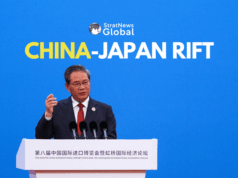NEW DELHI: In our series ‘Borderline Xi‘, Ambassador Nirupama Menon Rao, Former India Foreign Secretary, Ex-Envoy to China, the U.S. and Author, ‘The Fractured Himalaya: India Tibet China 1949-62′ in Kunnur, Tamil Nadu and from Washington, D.C., Lisa Curtis, Director, Indo-Pacific Security Programme at the Centre for a New American Security(CNAS), Co-author, ‘India-China Border Tensions and U.S. Strategy in the Indo-Pacific‘, Former Deputy Assistant to the U.S. President and foreign policy and national security expert with over 20 years of service in the U.S. government, including at the National Security Council (NSC), CIA, State Department, and Capitol Hill in conversation with StratNews Global Associate Editor Amitabh P. Revi. Ever since Xi Jinping took over as Chinese President in 2013, he has ensured border belligerence. Be it against India at Depsang, Chumar, Galwan in eastern Ladakh, recently at Yangtse in Arunachal Pradesh, against Bhutan on the Doklam plateau in 2017 or in the Taiwan Straits. All these operations have taken place under his watch. ‘Borderline Xi’ is a series on a decade of Chinese aggression, only on StratNews Global. Ambassador Nirupama Menon Rao discusses “the complete absence, the disappearance since Galwan of mutual trust(between India and China), the relationship at its nadir today”, the Yangtse clash in December 2022, “the deep historical association Tawang and the whole of Arunachal Pradesh has to the border dispute, the need to be eternally vigilant, strengthening infrastructure in the area”, China’s ‘invented names’ for places in India, reports of U.S. sharing real-time intelligence, India’s intelligence, surveillance and reconnaissance(ISR) capabilities, the difference between 1962 and 2023, the Pakistan-China two-front scenario, “the whole structure of the relationship we are building within the Quad”, Taiwan, Tibet and the One-China policy. Lisa Curtis discusses her co-authored paper, ‘India-China Border Tensions and U.S. Strategy in the Indo-Pacific’, China’s rationale for salami-slicing attempts, the latest being at Yangtse, “the likelihood of that increasingly continuing to happen along the border, India “narrowing the infrastructure differential”, the ‘Vibrant Village’ policy to counter Chinese border villages, the significance of the ‘foundational agreements’ with the U.S., leasing of MQ-9B drones, increased information exchange, Indian forces understanding the Chinese mindset, publicising commercial satellite information to tell the world what China is up to”, China’s two-front challenge, the Quad and what “full U.S. support in the event of another border crisis or conflict” means.




